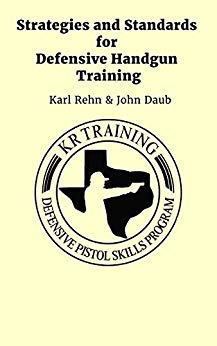Written by: Greg Ellifritz
A couple days ago I finished Karl Rehn and John Daub’s new book Strategies and Standards for Defensive Handgun Training.
I really enjoyed it and found it to contain a whole bunch of valuable information.
The authors’ book description follows:
“What percentage of carry permit holders attend training beyond the state minimum? What are the barriers keeping people from attending firearms training that isn’t mandatory? What are realistic standards for minimum defensive handgun competency? What are the best drills to practice? How can you compare the difficulty level of one drill to another? Written by two trainers with decades of experience, this book explores those questions and others related to defensive pistol training.”
The book masterfully answers those questions.
The authors begin be discussing gun student motivation for taking classes and research about how, as an instructor, you might best construct your classes and advertising to cater to those motivations. They then discuss the skills students need to prevail in a defensive encounter and how most basic pistol classes fail to adequately teach those skills.
Following that, they get into the meat of the book. They attempt to quantify exactly what standards a defensive shooter should aspire to. The start with the idea of “minimum competency” and then build the shooters’ skill sets from that point forward.
Towards the end of the book they break down various drills and tests with regards to skill levels, defining the skills necessary to pass each drill in terms of a percentage of the skill level necessary to shoot at the USPSA GrandMaster level.
I found this work very interesting, but I found the final part of the book to be the most valuable.
Karl and John listed a series of drills ranging from basic competency to requiring the proficiency of a high level competition shooter. More importantly, this series of drills is designed to be a workable plan for improvement if shot by the self-taught shooter. This list is quite unique among the training literature.
Lots of instructors have drill books. I regularly steer students toward the work of Mike Seeklander, Ben Stoeger, and Claude Werner to acquire shooting drills. I’ve read and used all those authors’ books. None of them laid out a practice regimen quite as simply as this book.
I predict that the set of drills the authors propose will be duplicated in many instructors’ future coursework. I certainly will use elements of it in my upcoming training classes.
Besides the drill analysis and progression plan, there are various short chapters about other elements of becoming a successful defensive shooter. I especially enjoyed John’s chapter titled “It’s not a miss, it’s an unacceptable hit.”
Two groups of people need to buy this book. The first is any instructor who wants to create a more logical progression of lessons in his or her classes. The second is any shooter who has been through a two or three day shooting school, has mastered the basic fundamentals, and wants to find drills to improve during structured practice sessions. I think the book will be invaluable for either of those groups.
I want to thank the authors for quoting me in the section about what standards and competence, discussing what my readers like in comparison to what I believe my readers need. The two are not in any way similar.
I also want to disclose that Karl sent me a free review copy of the book. He did so without any expectation of a review or any type of publicity. I am not getting compensated in any way by the authors for writing this review. It’s simply a good book and I think you should read it.
The book is available on Amazon.com.
Some of the above links (from Amazon.com) are affiliate links. If you purchase these items, I get a small percentage of the sale at no extra cost to you.

